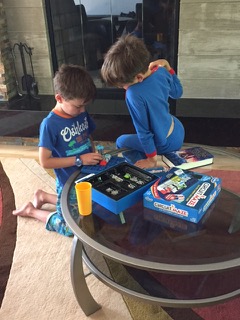 With all the emphasis on STEM learning and toys that can build skills in those areas of science, let’s not forget the language essential to and underlying this learning.
With all the emphasis on STEM learning and toys that can build skills in those areas of science, let’s not forget the language essential to and underlying this learning.
I always learn more about a toy from kids as they play with it. Over the weekend I saw a 10 year-old friend of mine at a picnic and told him I had a new circuit game for him to play with me. He was so excited that he let me know when he was leaving the party and was sitting outside my house waiting for me when I returned later. “Circuit Maze” didn’t disappoint as my friend got right to work figuring out the flow of electricity to light up his beacons. His independent play was accompanied by constant verbalizing his logic, thinking and discoveries, peppered with, “This is fun!” Lots of trial and error produced correct results as he lit up the beacons to show proper alignment of the positive and negative charged ends. This game was a confidence builder as kids completed the challenge cards (60 from beginner to expert), “I figured it out! Yes!” At first we couldn’t get the beacons to light up so my friend checked batteries and then his (+) and (-) sides of the pieces. He realized that the current has to flow out of the Start Token (+) into the (+) side of the Beacon. He declared, “So we figured out something for ourselves, instead of reading the directions!” It was such fun to hear my friend explain the working of circuits and beacons’ strengths to his 8 year-old brother who joined the play. He observed that the beacons didn’t always shine with the same intensity depending on the path. “The lights are the same strength if they split to go to the endpoint.” My little friend even started to engage in a little word play with me saying, “I’m almost positive the endpoint will be right here!”
STEM targeted games and toys are a great platform for building language as kids tell the why and how things work and what didn’t work too. Even the exercise of explaining the workings of circuits to his younger brother builds language skills of description and explanation. Kids are increasingly asked to explain their logic, choices, what worked and didn’t work and why, either orally or written in journals. I loved hearing my friend explain his thinking as he played, drawing conclusions and discovering concepts himself.
I got a further report from mom with the above picture of the boys in their PJ’s. Apparently my friend woke up and played “Circuit Maze” for an hour and a half and only stopped because he had to leave for the 4th of July parade! That’s an endorsement for how much fun learning can be!



